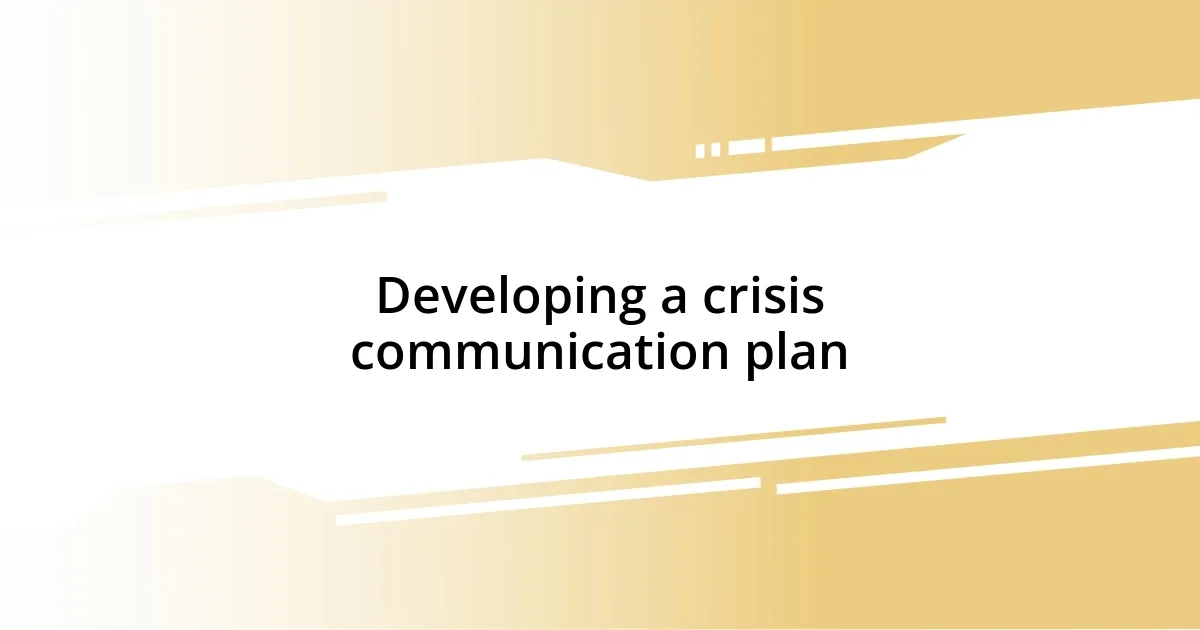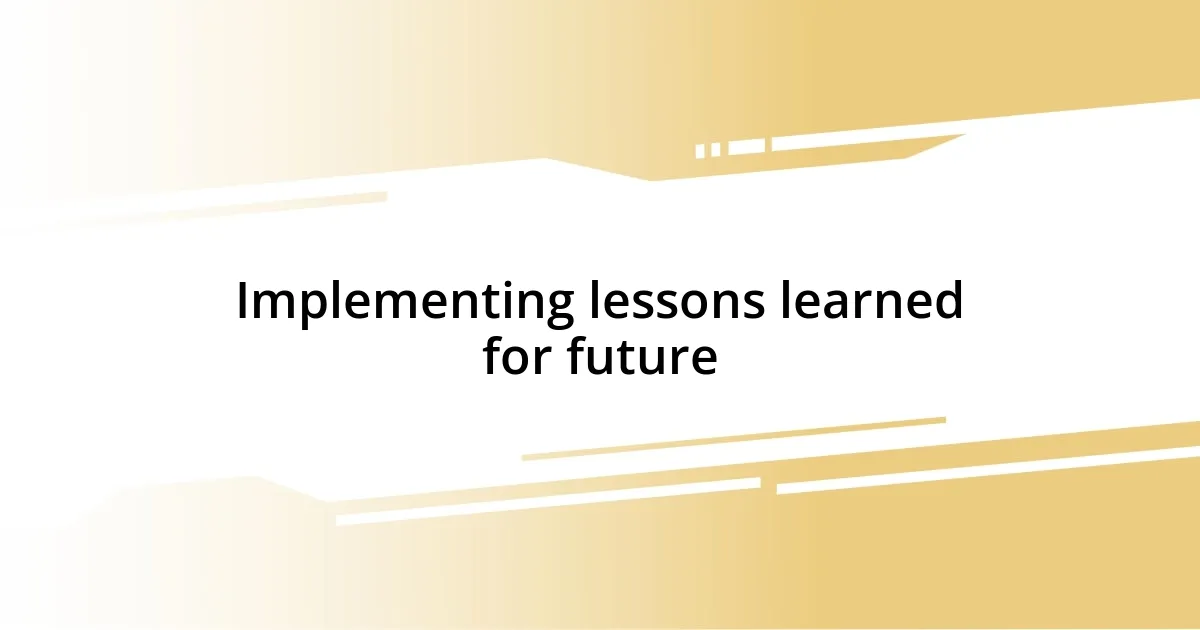Key takeaways:
- Early identification of a social media crisis requires monitoring engagement volume and sentiment to address issues before they escalate.
- A well-defined crisis communication plan, including roles and pre-drafted messages, enhances responsiveness and efficiency during a crisis.
- Engaging with the audience through prompt and empathetic communication fosters trust and community connection during difficult times.
- Post-crisis evaluations help measure the effectiveness of responses and inform future strategies, emphasizing the importance of integrating feedback for continuous improvement.

Identifying a social media crisis
A social media crisis can often feel like a sudden storm, catching brands off guard. When I first faced a crisis during my early marketing years, a single negative tweet went viral overnight. It was a wake-up call—realizing that a small issue could escalate quickly made me acutely aware of the power of social media.
In my experience, identifying a crisis is about recognizing the volume and tone of engagement around your brand. Have you ever noticed when a small complaint starts gaining traction? It’s those moments of heightened emotion, like outrage or disappointment, where you really need to pay attention. I learned that early intervention is crucial; once I started monitoring the underlying sentiments, I could address issues before they spiraled out of control.
An intriguing aspect is to watch for patterns. I remember analyzing a spike in negative comments relating to a specific product launch. It was like connecting the dots on a map—the more I looked, the more I understood the context behind the reactions. What I realized is that even when you think everything is fine, consistent monitoring can reveal cracks just waiting to widen.

Developing a crisis communication plan
Developing a crisis communication plan is like preparing a lifeboat before the storm hits. I learned firsthand that having a clear strategy in place allows you to respond swiftly and effectively when unexpected issues arise. Early in my career, when a brand I managed faced a social media backlash over a poorly-timed campaign, our pre-established guidelines enabled us to act quickly. We had drafted key messages ahead of time, which helped us maintain a sense of stability during the chaos.
A comprehensive plan should include designated roles within your team, ensuring that everyone knows their responsibilities. I recall a situation where clear roles helped us communicate seamlessly during a crisis. Each team member focused on their specific tasks—while I handled public responses, my colleagues monitored conversations and prepared internal updates. This division of labor not only safeguarded our response time but also reduced our stress levels during a chaotic period.
Finally, it’s essential to include regular updates and evaluations in your plan. Feedback from the crisis helps refine your approach for the future. I remember being part of a post-crisis review where we analyzed our responses and made pivotal changes to our strategy, leading to enhanced preparedness. This transformation highlighted just how valuable a proactive mindset is when navigating social media crises.
| Key Components | Description |
|---|---|
| Roles and Responsibilities | Clarify tasks for each team member during a crisis. |
| Pre-drafted Messages | Prepare key messages to deliver quickly and effectively. |
| Evaluation Process | Review responses post-crisis to improve future strategies. |

Engaging with your audience effectively
When engaging with your audience during a crisis, I believe it’s crucial to strike a balance between transparency and empathy. I remember navigating a particularly intense backlash where the community felt unheard and frustrated. Instead of just putting out a standard apology, I took a moment to really listen to their concerns. By actively responding to comments and acknowledging specific grievances, I found that I could rebuild a connection and foster trust. It’s vital to show that you’re not only aware of the issue but also genuinely care about your audience’s feelings.
Here are some effective strategies for engagement:
- Prompt Responses: Respond to comments as soon as possible to show you’re actively listening.
- Personalized Communication: Tailor your replies to specific concerns rather than using generic statements.
- Empathetic Tone: Use a compassionate voice that addresses feelings and demonstrates you understand their frustration.
- Invite Dialogue: Encourage followers to share their thoughts and experiences to facilitate ongoing conversation.
- Follow-Up: After resolving the issue, check in with your audience to keep the conversation going and maintain trust.
By weaving these strategies into your crisis response, you’ll create an atmosphere of openness that can turn a potential disaster into an opportunity for growth and connection.

Monitoring social media feedback
Monitoring social media feedback is crucial for timely responses during a crisis. I often find myself scrolling through comments and messages, absorbing the sentiments of our audience. One time, during an unexpected backlash over a product issue, I noticed that genuine concerns were being drowned out by negative commentary. By prioritizing feedback that needed immediate attention, I could address critical issues head-on, showing my audience that their voices mattered in a sea of noise.
I’ve learned that analyzing trends in feedback can reveal underlying patterns that may indicate deeper issues. For instance, during a particularly heated debate about our brand’s stance on social issues, I noticed clusters of similar complaints about a lack of transparency. This insight drove me to host a live Q&A session, where I had the opportunity to engage directly and clarify our position. Such proactive measures in monitoring engagement not only defuse tensions but also foster a stronger connection with the community.
It’s not just about fixing problems, though; tracking the tone of feedback is equally important. I recall a situation where a heartfelt response from my team led to a wave of support from our followers. That moment made me ponder: How does a single authentic interaction ripple out to create community goodwill? Monitoring isn’t merely about numbers; it’s about sensing the pulse of your audience and responding to their feelings with care.

Evaluating response effectiveness post-crisis
Evaluating response effectiveness post-crisis goes beyond counting likes and shares; it’s about genuinely understanding how your actions impacted your audience. I recall analyzing a crisis we faced last year, where our response generated a noticeable shift in public sentiment. By tracking engagement metrics alongside audience feedback, I discovered that heartfelt apologies led to conversations, rather than just muted acceptance. It made me wonder – did we truly mend the relationship, or was it just a temporary relief?
Through these evaluations, I often look at the emotional tone of discussions. After one crisis, I dove deep into social media sentiment analysis tools. The results were eye-opening; positive comments started to emerge alongside expressions of empathy from our audience. This nuanced feedback highlighted that we weren’t just repairing our image; we were fostering a community willing to engage with us. How can we measure this sense of community? It’s imperative to assess not only the immediate reactions but the long-term shifts in brand perception.
After a thorough evaluation, I also found that follow-up actions were integral. A few months after a crisis, I initiated a survey to gauge lingering sentiments. The responses revealed valuable insights; many felt more connected to our brand, while others expressed lingering doubts. This prompted me to implement transparency practices moving forward. I often ask myself: Are we evolving as a brand? By continuously reflecting on our responses and their aftermath, we can transform crises into opportunities for meaningful growth and connection.

Implementing lessons learned for future
One of the most valuable lessons I’ve gleaned from past crises is the importance of integrating feedback into our future strategies. For example, after a particularly challenging episode where our messaging fell flat, I found myself reflecting on why. It dawned on me that not only did we need to address our audience’s concerns, but we also had to evolve our communication style. This realization pushed me to curate a dedicated team that regularly reviews social media interactions, ensuring that we anticipate concerns before they escalate. How empowering is it to turn those hard-learned lessons into a proactive plan for the future?
Moreover, the emotional undercurrents from each crisis can inform our brand narrative moving forward. I remember a point in our journey when a heartfelt message acknowledged our audience’s frustrations. The outpouring of support was overwhelming, and it reminded me that vulnerability can foster trust. Thus, I now advocate for incorporating authentic storytelling into our content, highlighting not just our successes but also the lessons learned from our missteps. Isn’t it fascinating how sharing our journey can make our brand more relatable?
Lastly, committing to a post-crisis review not only becomes a standard practice but also a reflective exercise for our team. After resolving a major issue, I often gather the team to discuss what went well and what didn’t. It creates a safe space for learning, and I can empathize with how each member felt during the crisis. This shared vulnerability strengthens our bonds and reinforces the idea that we’re all in this together. How can we ignore the power of collective growth? By embracing these moments, I’ve found that we not only improve our strategies but also deepen our connections with each other and our audience.














